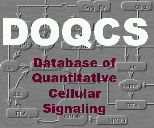| |
Reaction
Name | Pathway Name /
Pathway No. | Kf | Kb | Kd | tau | Reagents |
| 1 | bg-act-GEF | Ras
Pathway No. 318 | 6
(uM^-1 s^-1) | 1
(s^-1) | Kd(bf) = 0.1667(uM) | - | Substrate:
BetaGamma
inact-GEF
Products:
GEF-Gprot-bg
|
| SoS/GEF is present at 50 nM ie 3e4/cell. BetaGamma maxes out at 9e4. Assume we have 1/3 of the GEF active when the BetaGamma is 1.5e4. so 1e4 * kb = 2e4 * 1.5e4 * kf, so kf/kb = 3e-5. The rate of this equil should be reasonably fast, say 1/sec | | 2 | CaM-bind-GEF | Ras
Pathway No. 318 | 199.998
(uM^-1 s^-1) | 1
(s^-1) | Kd(bf) = 0.005(uM) | - | Substrate:
inact-GEF
CaM-Ca4
Products:
CaM-GEF
|
| We have no numbers for this. It is probably between the two extremes represented by the CaMKII phosph states, and I have used guesses based on this. kf=1e-4 kb=1 The reaction is based on Farnsworth et al Nature 376 524-527 1995 | | 3 | dephosph-GEF | Ras
Pathway No. 318 | 1
(s^-1) | 0
(s^-1) | - | - | Substrate:
GEF*
Products:
inact-GEF
|
| 4 | Ras-intrinsic-GT
Pase | Ras
Pathway No. 318 | 0.0001
(s^-1) | 0
(s^-1) | - | - | Substrate:
GTP-Ras
Products:
GDP-Ras
|
| This is extremely slow (1e-4), but it is significant as so little GAP actually gets complexed with it that the total GTP turnover rises only by 2-3 X (see Gibbs et al, JBC 265(33) 20437-20422) and Eccleston et al JBC 268(36) 27012-27019 kf = 1e-4 | | 5 | dephosph-GAP | Ras
Pathway No. 318 | 0.1
(s^-1) | 0
(s^-1) | - | - | Substrate:
GAP*
Products:
GAP
|
| Assume a reasonably good rate for dephosphorylating it, 1/sec | | 6 | dephosph-inact-G
EF* | Ras
Pathway No. 318 | 1
(s^-1) | 0
(s^-1) | - | - | Substrate:
inact-GEF*
Products:
inact-GEF
|
